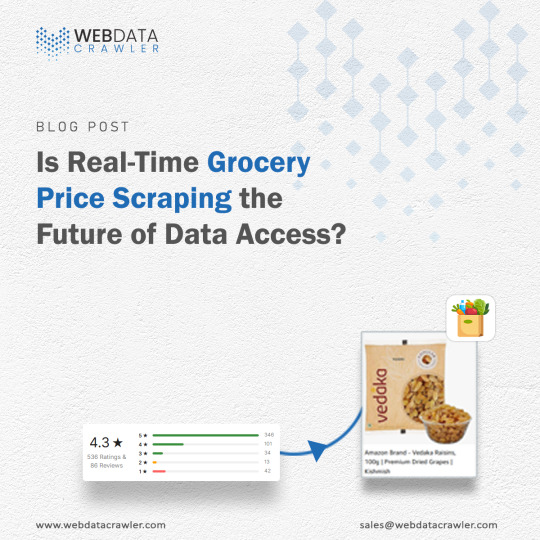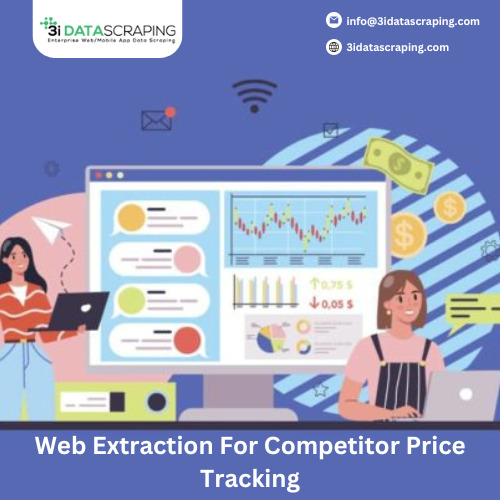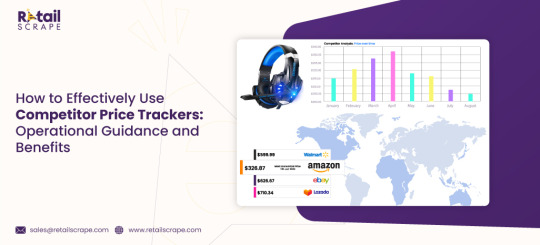#CompetitorPriceTrackingTools
Explore tagged Tumblr posts
Text
How to Effectively Use Competitor Price Trackers: Operational Guidance and Benefits

Introduction
In the dynamic landscape of eCommerce, pricing strategy stands paramount, especially for digital storefronts. Modern consumers are discerning, often prioritizing price comparison as a pivotal step before purchasing. The allure of securing the best deals and most competitive prices drives this behavior. Consequently, a significant portion of online shoppers actively engage in price monitoring across various platforms. Recognizing this trend, online retailers must adeptly employ competitor price trackers to stay ahead.
By leveraging retail data scraping techniques, businesses can collect comprehensive retail data, offering insights into the broader market's pricing landscape. Such price intelligence empowers retailers to craft a robust pricing strategy, bolstering sales, enhancing profit margins, and fostering customer loyalty. Moreover, a data-driven eCommerce pricing approach ensures competitiveness, with dynamic pricing becoming increasingly prevalent.
In essence, utilizing a competent competitor price tracker facilitates effective pricing optimization and solidifies a retailer's position in the fiercely competitive eCommerce arena.
Competitor Price Tracker - Meaning

A competitor price tracker is an invaluable tool in eCommerce, offering real-time insights into market pricing dynamics. Like specialized price comparison platforms, a competitor price tracker is tailored to gather and analyze pricing data pertinent to your marketplace. By leveraging retail data scraping methodologies, it systematically compiles comprehensive retail data collection focused on competitor pricing strategies.
This price intelligence software meticulously tracks and records fluctuations in competitor pricing. Whether it's observing price increments, reductions, or promotional offers, the tracker ensures you remain abreast of competitive pricing movements. Such data-driven insights are pivotal in formulating a robust pricing strategy. Businesses can adeptly implement dynamic pricing mechanisms by discerning market trends and competitor pricing patterns.
A proficient competitor price tracker empowers businesses to harness eCommerce pricing data effectively, facilitating informed pricing optimization and strategic positioning in the market landscape.
The benefits of competitor price tracking tools
Competitor price trackers have revolutionized how businesses approach pricing strategies in the digital age. Here's a deeper dive into the multifaceted benefits they bring to the table:
Time-Efficient Solutions
The digital marketplace operates at breakneck speed, with prices fluctuating continuously. Manually sifting through these changes is not only laborious but also inefficient. Competitor price trackers streamline this process, offering real-time price monitoring at the click of a button. This agility ensures businesses remain proactive rather than reactive in their pricing strategies.
Cost-Effectiveness
While there's an initial investment in procuring a competitor price tracking tool, it's judicious. Consider the expenses – both in terms of time and resources – associated with manual data collection. The efficiencies gained through automated retail data scraping and collection far outweigh the tool's costs, leading to substantial savings in the long run.
Enhanced Accuracy
Human errors are inevitable, especially when dealing with extensive datasets. Manual input of competitor pricing into systems amplifies this risk. Competitor price trackers mitigate this by offering precise, error-free data. This enhanced accuracy is pivotal for businesses aiming for data-driven pricing optimization and informed decision-making.
Informed Pricing Strategy
In the competitive landscape of eCommerce, knowledge is power. Competitor price trackers arm businesses with invaluable price intelligence. By accessing real-time eCommerce pricing data, businesses can discern market trends, analyze competitor strategies, and identify pricing patterns. This comprehensive understanding empowers businesses to craft dynamic pricing strategies that resonate with market dynamics, ensuring they remain competitive and profitable.
Competitor price trackers are indispensable tools for modern businesses. They offer real-time insights, enhance accuracy, and foster informed decision-making. As the eCommerce landscape evolves, leveraging such tools will be crucial for businesses striving for pricing excellence and sustained growth.
Navigating the Challenges of Competitor Price Tracking
In the intricate landscape of eCommerce, competitor price tracking emerges as a double-edged sword. While it promises invaluable insights for informed pricing decisions, it also presents intricate challenges that businesses must navigate cautiously.
The Illusion of Simplicity
Retail data scraping may seem straightforward at a cursory glance, with tools and methods accessible to a broad spectrum of users. However, this perception belies the complexities that lie beneath. A significant challenge arises in accurately matching products across platforms. For instance, even industry giants like Amazon grapple with barcode accuracy, hovering around 80%. Such nuances underscore the importance of expertise in ensuring precise retail data collection.
Accuracy Matters
The axiom "Garbage in, garbage out" holds immense significance in price intelligence. Only accurate or matched data can skew pricing strategies, leading to suboptimal pricing decisions that adversely impact sales and revenue. Given the stakes, entrusting competitor price tracking to seasoned professionals or advanced tools is imperative.
Evolution of Tracking Tools
Gone are the days when businesses relied solely on manual price comparison methods, a laborious and time-intensive endeavor. The digital age heralds a plethora of sophisticated competitor price trackers adept at retail data collection. These tools streamline the price monitoring process and enhance data accuracy, enabling businesses to focus on dynamic pricing strategies and pricing optimization.
Beyond Price – Value Proposition
While price remains a pivotal factor, today's discerning consumers prioritize value and overall shopping experience. Thus, businesses must adopt a holistic approach, leveraging comprehensive eCommerce pricing data to craft strategies that resonate with consumer preferences and market dynamics.
While competitor price trackers offer a treasure trove of insights, businesses must tread cautiously, recognizing the complexities involved. By harnessing advanced tools and expertise, they can unlock the full potential of price intelligence, driving growth and fostering consumer loyalty in the competitive eCommerce landscape.
Conclusion
Retail Scrape is a premier pricing intelligence platform meticulously designed to empower businesses in their competitive landscape. With the capability to monitor competitors and diverse marketplaces, Retail Scrape conducts retail data scraping across billions of price points globally each month. This extensive retail data collection ensures businesses gain unparalleled insights into competitor price trackers and market dynamics. By leveraging advanced algorithms, Retail Scrape offers actionable price intelligence, aiding businesses in shaping effective pricing strategies and dynamic pricing models. The platform's eCommerce pricing data extraction and analysis prowess is unparalleled, eliminating the need for manual input and effortlessly fostering pricing optimization. To delve deeper into the world of competitive price monitoring and witness the transformative potential of Retail Scrape, reach out for a complimentary trial today.
know more : https://www.retailscrape.com/competitor-price-trackers-guidance-benefits.php
#CompetitorPriceTrackers#CompetitorPriceTracking#CompetitorPriceIntelligence#CompetitorPriceTrackingTools#CompetitorPriceMonitoring#eCommercePricingDataExtraction
0 notes
Text

Is Real-Time Grocery Price Scraping the Future of Data Access?
Discover how Real-Time Grocery Price Scraping is transforming data access. Stay ahead of market trends, optimize pricing strategies, and gain valuable insights instantly. Read more: https://www.webdatacrawler.com/real-time-grocery-price-scraping.php
#RealTimeGroceryPriceScraping#GroceryPriceTrackingAPI#WebScrapingForRetail#EcommercePriceMonitoring#RetailDataExtractionTool#DynamicGroceryPriceTracking#LiveMarketPriceScraping#RealTimeRetailAnalytics#AutomatedGroceryDataScraping#CompetitorPriceTrackingTool
0 notes
Text

Web extraction for competitor price tracking enables businesses to gather real-time pricing data from competitors' websites. This information helps companies adjust their pricing strategies, stay competitive, and make informed decisions to maximize profitability and market share.
#competitorpricemonitoring#PriceScraping#competitorpricetracking#competitorpricescraping#competitorpricetrackingtool#competitorpricetrackingsoftware#webscrapingpricemonitoring
0 notes
Text

This blog shows how using a competent competitor price tracker facilitates effective pricing optimization and solidifies a retailers position in the fiercely competitive eCommerce arena.
know more : https://www.retailscrape.com/competitor-price-trackers-guidance-benefits.php
#CompetitorPriceTrackers#CompetitorPriceTracking#CompetitorPriceIntelligence#CompetitorPriceTrackingTools#CompetitorPriceMonitoring#eCommercePricingDataExtraction
0 notes
Text
How to Effectively Use Competitor Price Trackers: Operational Guidance and Benefits
This blog shows how using a competent competitor price tracker facilitates effective pricing optimization and solidifies a retailers position in the fiercely competitive eCommerce arena.
know more : https://www.retailscrape.com/competitor-price-trackers-guidance-benefits.php
#CompetitorPriceTrackers#CompetitorPriceTracking#CompetitorPriceIntelligence#CompetitorPriceTrackingTools#CompetitorPriceMonitoring#eCommercePricingDataExtraction
0 notes
Text
Is Real-Time Grocery Price Scraping the Future of Data Access?

Introduction
The retail grocery sector is rapidly evolving, and businesses, shoppers, and analysts are increasingly seeking ways to stay ahead of market trends, optimize pricing, and manage inventory efficiently. One technology that has the potential to revolutionize how we access grocery price data is Real-time grocery price scraping. This technology provides a wealth of opportunities for companies in the grocery and e-commerce industries, offering them the ability to monitor prices, track trends, and make data-driven decisions.
In this detailed blog, we will delve into what Real-time grocery price scraping is, how it works, its benefits, and its crucial role in shaping the future of grocery data access.
What is Real-Time Grocery Price Scraping?

Real-time grocery price scraping refers to the process of extracting real-time price data from grocery websites, e-commerce platforms, and online supermarkets. The goal is to gather up-to-date information on the prices of various grocery products. This enables businesses to track competitors' prices, monitor price fluctuations, and obtain insights into market trends without manually checking each website.
At its core, real-time scraping involves using automated tools, such as a Grocery data scraping API or API for scraping grocery product prices, to collect and present data from multiple sources in a structured, accessible format. Unlike traditional data collection methods, real-time grocery price scraping allows businesses to obtain accurate and timely information that can be used for competitive analysis, price optimization, and market forecasting.
How Does Real-Time Grocery Price Scraping Work?

Real-time grocery price scraping works by utilizing automated bots and APIs that navigate through grocery websites, extract relevant price data, and deliver it to the user in real time. This process can be broken down into the following steps:
Crawling the Website: The first step is to crawl or visit grocery websites and e-commerce platforms. This is done using a Web Data Crawler, which systematically explores the webpages to gather data.
Extracting Relevant Data: Once the crawler visits the page, it identifies and extracts the relevant data, which includes product names, prices, discounts, and other details. This can be done using a Grocery store data extraction API that enables the identification of specific data points within the page.
Real-Time Monitoring: After extracting the data, real-time monitoring tools continuously scan the website for price changes, promotions, and updates. This allows businesses to stay informed of price fluctuations and other market dynamics.
Data Structuring and Delivery: Finally, the extracted data is structured into a readable format, such as a spreadsheet or database, and delivered to the user via a Grocery data scraping API or a Price scraping API for groceries.
This process is highly efficient, fast, and accurate, allowing businesses to make decisions based on the most current data available.
Benefits of Real-Time Grocery Price Scraping

Real-time grocery price scraping offers a wide range of benefits for businesses in the retail and e-commerce sectors. Below are some of the key advantages of incorporating real-time scraping into your business operations:
1. Competitive Price Analysis
One of the primary benefits of Real-time grocery price comparison scraping is the ability to track and analyze competitors' prices in real time. With the help of a Grocery price tracking API, businesses can compare their own pricing strategies with those of competitors, ensuring they remain competitive in a rapidly shifting market. For example, a grocery store can monitor the prices of key products across various e-commerce platforms and adjust their prices accordingly to maintain competitiveness.
2. Price Optimization and Dynamic Pricing
Real-time price scraping for supermarkets plays a pivotal role in price optimization. By continuously tracking prices, grocery stores can implement dynamic pricing strategies, adjusting prices based on demand, competition, and market conditions. This is especially useful for large supermarkets and e-commerce platforms that need to manage thousands of products with different price points.
3. Informed Decision-Making
With access to up-to-the-minute pricing information, businesses can make informed decisions about their pricing strategies, product offerings, and promotions. Data collected through API for scraping grocery product prices can reveal trends in consumer behavior, helping grocery chains and e-commerce platforms develop tailored marketing strategies or adjust their inventory.
4. Streamlined Inventory Management
Real-time data scraping also aids in inventory management. By tracking the prices and availability of products, businesses can better predict demand fluctuations and adjust their inventory levels accordingly. For example, by using a Grocery data scraping API, businesses can track product availability across multiple retailers and adjust their stock levels to avoid understocking or overstocking certain items.
5. Enhanced Customer Experience
Consumers benefit from real-time grocery price scraping too. With the help of Real-time grocery price comparison scraping, shoppers can quickly compare prices across different platforms and make more informed purchasing decisions. This not only saves time but also ensures that consumers are getting the best deal possible.
6. Transparency and Trust
Real-time grocery price scraping fosters transparency in the market. By providing consumers with accurate, up-to-date pricing information, businesses can build trust with their customer base. Shoppers value price transparency, and offering this feature can improve customer loyalty.
Real-World Applications of Real-Time Grocery Price Scraping

The applications of Real-time grocery price scraping are vast and cover a wide range of business needs. Below are some key use cases for this technology:
1. Price Comparison Websites and Apps
Price comparison websites and apps are one of the most prominent users of Real-time grocery price scraping. These platforms aggregate price data from multiple grocery stores and online retailers, allowing users to compare prices of grocery items in real time. By using a Grocery price tracking API, these websites can continuously update product prices, providing users with the most accurate and current information.
2. E-Commerce Platforms and Online Grocery Stores
For e-commerce platforms and online grocery stores, Real-time grocery price scraping is essential for staying competitive. By constantly monitoring competitor prices using a Grocery store data extraction API, these platforms can adjust their pricing in real time, ensuring they offer the best value to their customers.
3. Retailers and Supermarkets
Supermarkets, both online and brick-and-mortar, use Real-time price scraping for supermarkets to adjust their prices and promotions. By scraping competitor data and monitoring product prices, supermarkets can offer discounts, run promotions, and optimize their pricing strategies based on live market data.
4. Market Research and Analytics Companies
Market research companies use Price scraping API for groceries to collect data on grocery prices, consumer behavior, and shopping trends. This data is invaluable for generating reports, forecasting market trends, and providing insights to clients across various industries.
5. Supply Chain and Logistics
Supply chain managers can use Scrape Grocery data access API to track grocery prices across multiple suppliers. This helps them identify the most cost-effective suppliers and make data-driven decisions about procurement and logistics.
How to Implement Real-Time Grocery Price Scraping?

Implementing Real-time grocery price scraping requires a few key steps:
1. Choose the Right API
There are several APIs available for scraping grocery product prices, so it’s important to choose the one that best suits your needs. Some of the popular APIs include the Grocery data scraping API, the Grocery price tracking API, and the Price scraping API for groceries. Consider factors such as the number of supported websites, data accuracy, and real-time capabilities when choosing your API.
2. Set Up a Web Data Crawler
A Web Data Crawler is essential for efficiently navigating websites and extracting relevant pricing data. You can either build your own crawler or use an existing tool that integrates with your Grocery store data extraction API.
3. Monitor Data in Real Time
Once you have your API and crawler set up, it’s crucial to monitor data in real time. This means constantly scraping websites and checking for price updates and product availability. Many APIs provide built-in monitoring features, but it’s important to set up alerts to notify you when there are significant price changes.
4. Ensure Data Accuracy and Compliance
When scraping data, ensure that you comply with the terms of service of the websites you are targeting. It’s also important to verify that the data you collect is accurate and up-to-date, as inaccurate data can lead to poor decision-making.
5. Integrate the Scraped Data into Your Systems
After scraping, the data should be integrated into your business systems for analysis, reporting, and decision-making. This could involve feeding the data into a dashboard, CRM, or pricing engine to support dynamic pricing strategies.
Conclusion
Real-time grocery price scraping is poised to shape the future of data access in the grocery and retail industries. The ability to automatically collect and analyze real-time pricing data offers businesses a significant competitive advantage, enabling them to optimize pricing strategies, track market trends, and improve the customer experience.
With the right tools, such as a Grocery data scraping API or a Price scraping API for groceries, businesses can harness the power of real-time data to stay ahead of competitors and make more informed decisions. Whether you're in the grocery retail business, e-commerce, or market research, Real-time grocery price scraping is a game-changer that can revolutionize how you access and utilize data.
If you're ready to unlock the power of real-time grocery price scraping, consider using Web Data Crawler solutions. Contact us today to learn how we can help you integrate real-time price scraping into your business and gain valuable insights into the grocery market.
Originally published at https://www.webdatacrawler.com.
#RealTimeGroceryPriceScraping#GroceryPriceTrackingAPI#WebScrapingForRetail#EcommercePriceMonitoring#RetailDataExtractionTool#DynamicGroceryPriceTracking#LiveMarketPriceScraping#RealTimeRetailAnalytics#AutomatedGroceryDataScraping#CompetitorPriceTrackingTool
0 notes